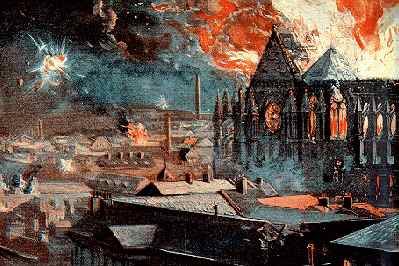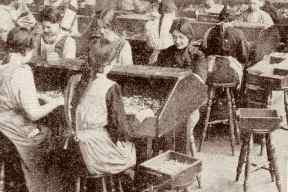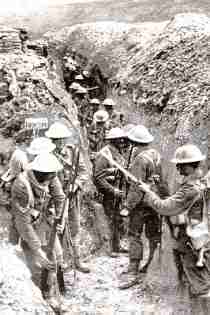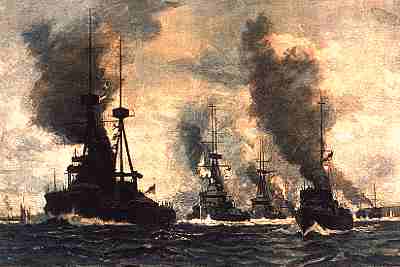
| The Journal for MultiMediaHistory Volume 1 Number 1 ~ Fall 1998 |
The First World War and Its Consequences. Princeton, New Jersey: Films for the
Humanities and Sciences, 1996. CD-ROM. PC, Windows 3.1 or Windows 95. [For more information go to: www.films.com.]
 |
Films for the Humanities and Sciences has one of the most extensive collections of scholarly videos, videodiscs and CD-ROMs available (rapidly approaching 6,000 titles). The First World War and Its Consequences makes good use of paintings, photographs, illustrations, videoclips, and sound clips of veterans recounting their experiences in bringing the story of that tragedy to life. Divided into ten modules (chapters), there is ample material to consider: "Causes of the First World War"; "Major Events"; "The First Onslaught"; "Russia and the Eastern Front"; "The Home Front"; "War at Sea and in the Air"; "The Coming Victory"; "The Post-War Period"; and a final section devoted to "Mr. Punch's History of the Great War," reproducing twenty-four famous pictures from the British illustrator. This is particularly valuable in that it gives a strong sense of how the British coped with the war, stiff upper lip and all. Each module contains from twenty-four to fifty "pages," each accompanied by a visual text and sound.
The major focus is on the British experience; the narrators (one male, the other female) speak impeccable Queen's English, thus giving the work an even more British cast. An occasional idiosyncratic English expression (e.g., "midden" for dunghill) is translated for the benefit of Americans.
 |
factory during World War I. From The First World War and Its Consequences. |
 |
The First World War and Its Consequences. |
A brief introduction reveals the historiographic framework of the CD-ROM. The authors and collaborators (never cited) are squarely in the tradition of the English historian A.J.P. Taylor and the dominant interpretation that Germany and Austria-Hungary bear "considerable responsibility for provoking the conflict." While most historians of the time had pointed to the diplomatic and political factors, Taylor emphasized the role of chance, popular feeling, and individual shortcomings in starting the war. The "revisionist" interpretation, put forth by Germany and some American historians as early as the 1920s and 1930s, that Germany was justly responding to its "encirclement" by Britain, France, and Russia, is mentioned and then dismissed. No mention is made of the German historian Fritz Fischer's revolutionary thesis, first presented in 1962, that Germany bore the overwhelming moral and political burden of creating the conditions and then starting the war. Although many will be familiar with the role of German submarine warfare and the Allied response, that front has usually taken second place to the western front. This work argues, on the contrary (and perhaps not coincidentally since it is a British production), that Allied control of the world's shipping lanes was "the crucial element in bringing Germany to her knees in 1918."
Several themes shape the work throughout: the frantic pace at which technology was developed and implemented including planes, tanks, submarines, the machine gun, and gas warfare. This "technology of mass death" was the dominant reality of the war, often waylaying the best laid plans of the general staffs on both sides of the conflict. The French military strategy of a noble, heroic, and dashing infantry charge after extensive artillery bombardment was shown to be pure folly in the face of German machine-gunners. A war of movement in the west quickly degenerated into the horror of trench warfare, as neither side was able to deliver the knockout blow. Conditions in the east were different; there the wide-open spaces of Prussia and the Russian front made for a more "fluid" and traditional, yet no less devastating, war.
The experiences and voices of the combatants are used well throughout. We are informed of the vast and almost unimaginable losses sustained by both sides. It was not unusual for tens of thousands of men to be killed for the sake of a few miles of devastated land, only for that worthless property to fall back to the enemy. As the numbers become abstract, the microcosmic dimensions of the war assume greater power: soldiers marched under the burden of fifty pounds of supplies, their greatcoats�weighing seven pounds dry�would often soak up enough rain to weigh fifty pounds wet. When gas was first used and before masks were sent to the front, soldiers in the trenches would place pads soaked with their own urine to their faces in a desparate effort to stave off the effects of the chlorine, mustard, or nerve gas. Consider this description of the nightmare of trench warfare: "In the summer clouds of flies feasted on the corpses and then settled on the soldiers' food. Throughout the year large fearless rats roamed the trenches. The reek of death was everywhere . . . Abandoned trenches were often converted into mass graves only to be uncovered when the shelling started again. The soldiers' clothing became infested with lice which were impossible to remove. Constant standing in water often led to 'Trenchfoot' which, if it got out of control, could rot a man's foot away." Details such as these are no doubt very effective in bringing home the horror of the war.
There is, though, another issue that needs to be addressed�one that is more often associated with the Holocaust: is it possible to reproduce the events and effects of such an immense human tragedy without descending into banalities, gross generalizations, and kitsch? Is it possible to "know" the Holocaust or the First World War? Is it enough to supplement diaries and interviews with veterans, nurses, officers, and artists to the diplomatic record? These materials allow us to get closer to the truth, but carry with them a particular epistemological problem. All of the recorded voice interviews here are of British soldiers; was the German soldier's experiences in the

|
From The First World War and Its Consequences. |
These considerations are not directly addressed in the CD-ROM. They may have been confronted in its preparation, but an honest depiction of the problems in crafting such a work would undoubtedly make it a stronger work. This consideration should lead to an examination of the role of such material in learning and the classroom. How can educators teach students to deal with the overwhelming amount of information available today? What are the epistemological and pedagogical issues that must be confronted in the Information Age? How can we teach students to recognize what is valuable from the dross? All too often these days, teachers are presented with carefully-crafted and stunningly-illustrated research papers; yet when it comes down to evaluating the text and ideas, these slick productions often come up short on ideas and analysis. With the visually-arresting images and wonderful narrators, students might not have to read any text at all. At $149, this CD-ROM will not be in every student's collection, but it probably will be accessible through their library. Although such works will no doubt attract students to the subject more so than a traditional historical monograph, will it foster the skills of critical reading, intelligent analysis, and rigorous evaluation that we wish to impart? There is no reason to dismiss the possibility that students learn to "read" a CD-ROM, film, or advertisement as rigorously and critically as they may a more traditional text.
The First World War and Its Consequences is a visually interesting and at times thought-provoking work, but one that should be considered supplemental rather than fundamental.
Stanislao G. Pugliese
Hofstra University
![]() Comments
to: [email protected]
Comments
to: [email protected]
Contents: JMMH, Volume 1 Number 1 ~ Fall 1998